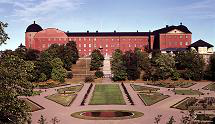Speaker
Mr
Andrzej Pyszniak
(Jagiellonian University in Krakow, Uppsala University)
Description
Frozen microspheres of hydrogen, so called pellets, are used as targets in the hadron physics experiment WASA (Forschungszentrum Juelich, Germany) [1] and will also be used in the future PANDA experiment at FAIR (GSI, Darmstadt, Germany) [2].
Pellets have a diameter of 25-30 micrometers. They are generated 2 - 3 meters above the interaction region, to which they travel inside a thin pipe (the space between pellet generation point and the interaction point is occupied by the particle detector system). The distance between the pellets is in the order of a few millimeters and they form a stream of a few millimeters in diameter. The interaction region is given by the overlap of the pellet stream and the accelerator beam and has a size of a few millimeters.
One would like to know the interaction point more precisely, to have better possibility to reconstruct the particle tracks coming from the reaction point. One would also like to suppress background events that do not come from a pellet, but e.g. may occur in rest gas, that is present in the beam pipe.
A solution is provided by the presented pellet tracking system, for which a prototype [3] has been developed at Uppsala Pellet Test Station (The Svedberg Laboratory, Uppsala, Sweden). The goal of the system is to track single pellets in order to know their position at the time of an interaction. The desired resolution is a few tenths of a millimeter. The tracking will be realized using lasers and fast line-scan (i.e. one dimensional) CCD cameras. The cameras, placed at different levels along the pellet stream, will measure pellets position and time of passage. Then, the information from many cameras will be put together to identify and reconstruct the track of each pellet. Information about the pellet position in the interaction region at the time of an interaction will be used in the analysis of the experimental data.
To be useful, the tracking system must be highly efficient and provide tracking information for essentially all pellets that pass the interaction region. The design of such a system, simulation techniques and results will be presented.
References:
[1] WASA-at-COSY Collaboration: H.-H. Adam et al., arXiv:nucl-ex/0411038 (2004).
[2] Physics Performance Report for PANDA: Strong Interaction Studies with Antiprotons, W. Erni et al., PANDA Collaboration, http://arxiv.org/abs/0903.3905v1 (2009).
[3] H. Calen et al., Forschungszentrum Juelich IKP Annual Report, (2011).
Primary author
Mr
Andrzej Pyszniak
(Jagiellonian University in Krakow, Uppsala University)
Co-authors
Dr
Hans Calen
(Uppsala University)
Dr
Kjell Fransson
(Uppsala University)
Dr
Marek Jacewicz
(Uppsala University)
Prof.
Tord Johansson
(Uppsala University)
Prof.
Zbigniew Rudy
(Jagiellonian University in Krakow)

